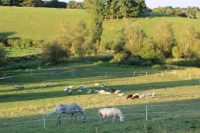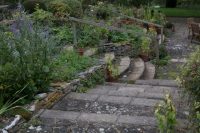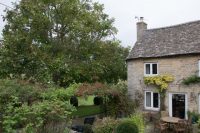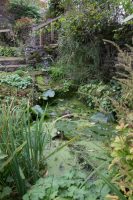The garden I grew up in
My mum Clare Stott, died a couple of weeks ago aged 94. Her funeral is tomorrow. There are many things I remember her for, but one of the most consistent threads in our lives was the shared passion in plants and growing. We moved to the house in north Oxfordshire that became the family home, in 1960 and in which she died fifty six years later. At the time my parents bought it, the house had been abandoned for some years and was only accessible from the nearby village of Wootton near Woodstock across the fields. The cottages were on a hilltop overlooking a spectacular view of the Glyme valley.  Earliest memories are of my parents trying to create a garden from a steep hillside covered with limestone. Corn brash soil strictly speaking. The only way to create a cultivatable garden was to construct walls and paths out of the huge quantities of stone, and carve out little beds for plants in between. That engagement between slope, stone and soil was the basis of their gardening, and a major influence on mine. Garden structure was crucial, and from an early age I was taught how to construct traditional Cotswold dry stone walls from the materials readily available. Holding the other end of the lines and pegs while my dad Frank measured and used a level to design the network of steps linking paths, patches of lawn, and the arches and gates in walls that were to make up the garden was another formative experience.
Earliest memories are of my parents trying to create a garden from a steep hillside covered with limestone. Corn brash soil strictly speaking. The only way to create a cultivatable garden was to construct walls and paths out of the huge quantities of stone, and carve out little beds for plants in between. That engagement between slope, stone and soil was the basis of their gardening, and a major influence on mine. Garden structure was crucial, and from an early age I was taught how to construct traditional Cotswold dry stone walls from the materials readily available. Holding the other end of the lines and pegs while my dad Frank measured and used a level to design the network of steps linking paths, patches of lawn, and the arches and gates in walls that were to make up the garden was another formative experience.  Perhaps unsurprisingly in the context, they were both active in the Alpine Garden Society and early memories include plenty of small alpines being planted, especially in the walls, paths, and nooks and crannies on steps. Equally unsurprisingly they they gravitated towards other such gardeners and garden designers.
Perhaps unsurprisingly in the context, they were both active in the Alpine Garden Society and early memories include plenty of small alpines being planted, especially in the walls, paths, and nooks and crannies on steps. Equally unsurprisingly they they gravitated towards other such gardeners and garden designers.
One was Margery Fish, author of ‘We made a garden’, and I well recall a visit to her house and garden in East Lambrook in Somerset as a child. What a charming old lady she was! And what an amazing garden, helped of course by the house being the village manor house. The book, published sixty years ago, records her struggles both with the terrain and soil, but also (especially) with her husband Walter (long since dead by the time we visited in the 1960’s) who perhaps predictably as the ex-Editor of the Daily Mail, had a view of gardening as something where plants and lawns were to be controlled and tamed. Not so Margery Fish, who whose attempts to break up the symmetry of his paths with ‘tiny green plants that would creep along all the stones’ had to await his departure, where upon ‘…a lot of the Somerset cement became loosened, some of  it helped, I admit by a crowbar..’ and ‘now I have little plants creeping and crawling out of nearly every crevice..’ Just like my parents garden, to which she paid a return visit to much to my mum’s delight.
it helped, I admit by a crowbar..’ and ‘now I have little plants creeping and crawling out of nearly every crevice..’ Just like my parents garden, to which she paid a return visit to much to my mum’s delight.
Walls need plants growing up them, and paths need to lead somewhere, often to openings in the walls, with arches. Wisteria on the walls of the cottages, clematis especially a white one covering an arch, and red tulips in a long border running down the side of the dry stone wall that marked the edge of the orchard, were some of her favourite plants. Perhaps the rather unrelenting nature of the soil – if that is what you could call all that stone, led to a particular delight in winter flowering plants – grey stone, mist, leafless trees and bursts of colour; cyclamen in drifts across the lawns, were definitely a favourite. The interaction between stone, foliage, garden ornament – the stone cockerel, the sundial on its stone plinth, the pond with its little statue and tiny stream of running water,  bounded by an old stone wall that preceded our arrival and separated garden from orchard and field beyond. All in all it was an interpretation of the traditional ‘cottage garden’ (after all it was a garden round two old and converted cottages…) designed for the circumstances; a largely north facing slope where the views across the Glyme and towards the small village of Wootton clinging to the valley on the other (south facing) side were as much of an attraction as the content of the garden itself.
bounded by an old stone wall that preceded our arrival and separated garden from orchard and field beyond. All in all it was an interpretation of the traditional ‘cottage garden’ (after all it was a garden round two old and converted cottages…) designed for the circumstances; a largely north facing slope where the views across the Glyme and towards the small village of Wootton clinging to the valley on the other (south facing) side were as much of an attraction as the content of the garden itself.
Space, colour (the rose garden especially), views, garden as separate ‘rooms’ bounded by ancient walls with openings and arches, climbers, foliage and occasional carefully positioned trees and shrubs were its signatures. Room for vegetables and compost heaps? Certainly, but the kitchen garden had it place by the garage, not for daily contemplation. Strategically placed compost heaps were screened by annuals and clematis climbing over low walls, within striking distance of the kitchen, but just out of sight of the kitchen window. I won’t say that my own garden in the middle of a city and just 67 by 26 foot replicates much of this, but the learning is there, and for that I am very grateful.

